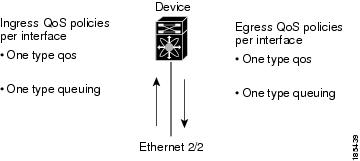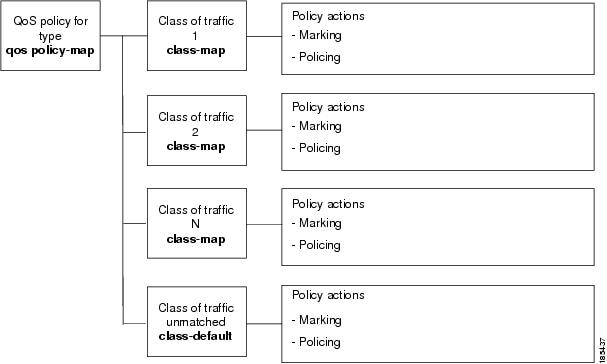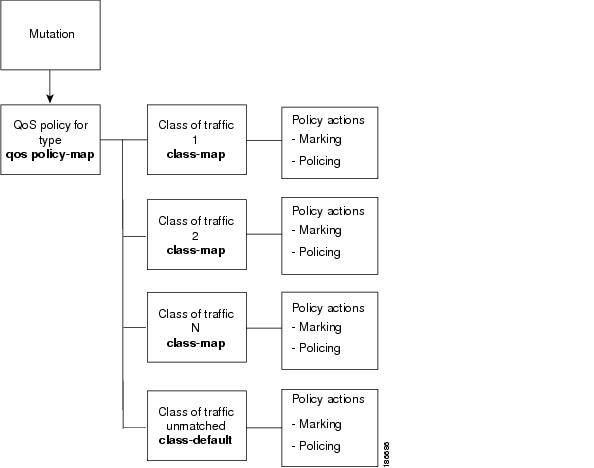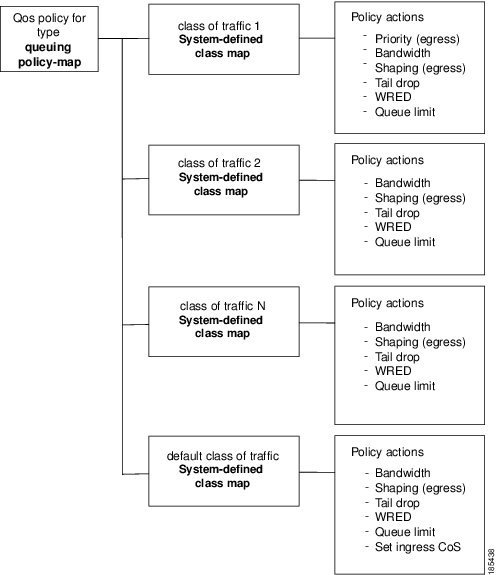

Table Of Contents
Licensing Requirements for Using MQC Objects
Configuring or Modifying a Class Map
Configuring or Modifying a Table Map
Configuring or Modifying a Policy Map
Applying Descriptions to MQC Objects
Attaching and Detaching a QoS Policy Action from an Interface
Feature History for Using Modular QoS CLI
Using Modular QoS CLI
This chapter describes how to configure Modular QoS CLI (MQC) objects that can be used for configuring QoS features.
This chapter includes the following sections:
•
Licensing Requirements for Using MQC Objects
•
Attaching and Detaching a QoS Policy Action from an Interface
•
Feature History for Using Modular QoS CLI
Information About MQC
MQC provides a language to define QoS policies.
Note
MQC commands are included in the Cisco Nexus 7000 Series NX-OS Quality of Service Command Reference, Release 4.0
You configure QoS policies using three steps:
1.
Define traffic classes.
2.
Associate policies and actions with each traffic class.
3.
Attach policies to logical or physical interfaces and VLANs.
MQC provides three command types to define traffic classes and policies:
•
class-map—Defines a class map that represents a class of traffic based on packet-matching criteria. Class maps are referenced in policy maps.
•
table-map—Defines a table map that represents a mapping from one set of packet field values to another set of packet fields. Table maps are referenced in policy maps.
•
policy-map—Defines a policy map that represents a set of policies to be applied on a class-by-class basis to class maps.
You define the following class-map and policy-map object types when you create them:
•
qos—Defines MQC objects that you can use for marking and policing.
•
queuing—Defines MQC objects that you can use for queuing and scheduling.
Note
The qos type is the default.
You can attach policies to ports, port channels, VLANs, subinterfaces, or tunnels by using the service-policy interface configuration command.
You can view all or individual values for MQC objects by using the show table-map, show class-map, and show policy-map commands.
Note
The system may accept QoS and ACL commands if you are working in the interface configuration mode and the module on which the interface is present is reloaded, even if that module is not present in the system at that time.
Licensing Requirements for Using MQC Objects
The following table shows the licensing requirements for this feature:
However, using VDCs requires an Advanced Services license.
Using an MQC Object
You configure QoS and queuing policies using the MQC class-map, policy-map, and table-map objects. You cannot use table maps in queuing policies. After you configure class maps and policy maps, you can attach one policy map of each type to each of the ingress or egress directions of an interface. Figure 2-1 lists the maximum QoS and queuing policies that you can define on each interface.
Figure 2-1 Maximum QoS Policies Per Interface
A policy map contains either a QoS policy or queuing policy. The policy map references the names of class maps that represent traffic classes. For each class of traffic, the device applies the policies on the interface or VLAN that you select.
A packet is matched sequentially to a class of traffic starting from the first traffic class definition. When a match is found, the policy actions for that class are applied to the packet.
The reserved class map receives all traffic that is not matched in type qos policies, and the device applies the policy actions as it would for any other traffic class. You use class-default to perform mutations (mutation is a method for translating QoS values in the packet header prior to traffic classification).
Note
You can access user-defined MQC objects only in the virtual device context (VDC) in which they were created. You can access the system-defined MQC objects in all VDCs.
This section includes the following topics:
•
Applying Descriptions to MQC Objects
Type qos Policies
You use type qos policies to mark, to apply mutations, to set the ingress port trust state, and to police packets.
Figure 2-2 shows the QoS policy structure with the associated MQC objects of type qos without mutation, and Figure 2-3 shows the QoS policy structure with mutation. The MQC objects are shown in bold.
Figure 2-2 QoS Policy Diagram Showing Type qos MQC Object Usage without Mutation
Figure 2-3 QoS Policy Diagram Showing Type qos MQC Object Usage with Mutation
Type queuing Policies
You use type queuing policies to mark, shape, and queue packets. Marking is limited to the CoS field and does not support the use of table maps.
Figure 2-4 shows the QoS policy structure with associated MQC objects of type queuing. The MQC objects are shown in bold.
Note
MQC table-map objects cannot be used in policies of type queuing.
Figure 2-4 QoS Policy Diagram Showing Type queuing MQC Object Usage
System-Defined MQC Objects
Note
These are the default MQC objects. All of these values apply across all VDCs.
When you configure QoS features, and the systems requests one of these MQC objects, you can use these system-defined objects.The system-defined MQC objects are shown in Table 2-1. See the tables listed next to the object for information on these system-defined objects.
Table 2-1 System-Defined MQC Objects
Type qos class maps
Type queuing class maps
Table maps
Policy maps
Type qos class maps that are defined by the system are listed in Table 2-2.
Note
You cannot reference the conform-color-in, conform-color-out, exceed-color-in, or exceed-color-out class maps in a policy map.
Type queuing class maps that are defined by the system are listed in Table 2-3.
Table 2-3 System-Defined Type queuing Class Maps
1 Gigabit Module Ingress: 2 queues with 4 thresholds per queue
2q4t-in-q1
Ingress queue 1 of 2q4t type
5-7
2q4t-in-q-default
Ingress default queue of 2q4t type
0-4
1 Gigabit Module Egress: 1 strict priority queue and 3 normal queues with 4 thresholds per queue
1p3q4t-out-pq1 1
Egress priority queue of 1p3q4t type
5-7
1p3q4t-out-q2
Egress queue 2 of 1p3q4t type
-
1p3q4t-out-q3
Egress queue 3 of 1p3q4t type
-
1p3q4t-out-q-default
Egress default queue of 1p3q4t type
0-4
10 Gigabit Module Ingress: 8 queues with 2 thresholds per queue
8q2t-in-q1
Ingress queue 1 of 8q2t type
5-7
8q2t-in-q2
Ingress queue 2 of 8q2t type
-
8q2t-in-q3
Ingress queue 3 of 8q2t type
-
8q2t-in-q4
Ingress queue 4 of 8q2t type
-
8q2t-in-q5
Ingress queue 5 of 8q2t type
-
8q2t-in-q6
Ingress queue 6 of 8q2t type
-
8q2t-in-q7
Ingress queue 7 of 8q2t type
-
8q2t-in-q-default
Ingress default queue of 8q2t type
0-4
10 Gigabit Module Egress: 1 strict priority queue and 7 normal queues with 4 thresholds per queue
1p7q4t-out-pq1 1
Egress priority queue of 1p7q4t type
5-7
1p7q4t-out-q2
Egress queue 2 of 1p7q4t type
-
1p7q4t-out-q3
Egress queue 3 of 1p7q4t type
-
1p7q4t-out-q4
Egress queue 4 of 1p7q4t type
-
1p7q4t-out-q5
Egress queue 5 of 1p7q4t type
-
1p7q4t-out-q6
Egress queue 6 of 1p7q4t type
-
1p7q4t-out-q7
Egress queue 7 of 1p7q4t type
-
1p7q4t-out-q-default
Egress default queue of 1p7q4t type
0-4
1 These are either priority or normal queues. If you use the priority keyword in your configuration, these are used as priority queues. Otherwise, they are used as normal queues.
Table maps that are defined by the system are listed in Table 2-4. The default mapping of values in the tables maps is contained in RFC 2597.
Policy maps that are defined by the system are listed in Table 2-5.
Configuring an MQC Object
When you specify a MQC object command, the device creates the object if it does not exist and then enters map mode.
To remove a class-map, table-map, or policy-map object, use the no form of the command that you used to create the object.
For the commands that you can use in the MQC object mode, see the following configuration chapters:
•
Chapter 3, "Configuring Classification"
•
Chapter 4, "Configuring Marking"
•
Chapter 5, "Configuring Mutation Mapping"
•
Chapter 6, "Configuring Policing"
•
Chapter 7, "Configuring Queuing and Scheduling"
This section includes the following topics:
•
Configuring or Modifying a Class Map
•
Configuring or Modifying a Table Map
•
Configuring or Modifying a Policy Map
Configuring or Modifying a Class Map
You can create or modify a class map. You can then reference class maps in policy maps.
Note
You cannot create a queuing class map; you must use one of the system-defined queuing class maps listed in Table 2-3.
SUMMARY STEPS
1.
config t
2.
class-map [type qos] [match-any | match-all] class-map-name
3.
exit
4.
class-map [type qos] {conform-color-in | conform-color-out | exceed-color-in | exceed-color-out}
5.
exit
6.
class-map type queuing match-any class-queuing-name
7.
exit
8.
show class-map [type qos] [class-map-name | conform-color-in | conform-color-out | exceed-color-in | exceed-color-out]
9.
show class-map type queuing [class-queuing-name]
10.
copy running-config startup-config
DETAILED STEPS
Step 1
config t
Example:
switch# config t
switch(config)#
Enters configuration mode.
Step 2
class-map [type qos] [match-any | match-all] class-map-name
Example:
switch(config)# class-map class1
switch(config-cmap-qos)#
Creates or accesses the class map of type qos, and then enters class-map qos mode. Class-map names can contain alphabetic, hyphen, or underscore characters, are case sensitive, and can be up to 40 characters.
Step 3
exit
Example:
switch(config-cmap-qos)# exit
switch(config)#
Exits class-map qos mode and enters configuration mode.
Step 4
class-map [type qos] {conform-color-in | conform-color-out | exceed-color-in | exceed-color-out}
Example:
switch(config)# class-map exceed-color-in
switch(config-color-map)#
(Optional) Accesses the class map of type qos for one of the system-defined color maps, and then enters color-map mode.
Note
This is only used when color-aware policing is required.
Step 5
exit
Example:
switch(config-color-map)# exit
switch(config)#
Exits color-map mode, and then enters configuration mode.
Step 6
class-map type queuing match-any [class-queuing-name]
Example:
switch(config)# class-map type queuing match-any 1p3q4t-out-pq1
switch(config-cmap-que)#
Creates or accesses the class map of type queuing, and then enters class-map queuing mode. Class queuing names are listed in Table 2-3.
Step 7
exit
Example:
switch(config-cmap-que)# exit
switch(config)#
Exits class-map queuing mode and enters configuration mode.
Step 8
show class-map [type qos] [class-map-name | conform-color-in | conform-color-out | exceed-color-in | exceed-color-out]
Example:
switch(config)# show class-map
(Optional) Displays information about all configured class maps or a selected class map of type qos.
Step 9
show class-map type queuing [class-queuing-name]
Example:
switch(config)# show class-map type queuing
(Optional) Displays information about all configured class maps or a selected class map of type queuing. Class queuing names are listed in Table 2-3.
Step 10
copy running-config startup-config
Example:
switch(config)# copy running-config startup-config
(Optional) Saves the running configuration to the startup configuration.
Configuring or Modifying a Table Map
You can create or modify a table map that you can reference in policy maps. See Chapter 4, "Configuring Marking" for information on configuring table maps.
SUMMARY STEPS
1.
config t
2.
table-map table-map-name
3.
exit
4.
table-map {cir-markdown-map | pir-markdown-map | cos-discard-class-map | cos-dscp-map | cos-precedence-map | dscp-cos-map | dscp-precedence-map | dscp-discard-class-map | precedence-dscp-map | precedence-cos-map | precedence-discard-class-map | discard-class-cos-map | discard-class-prec-map | discard-class-dscp-map}
5.
exit
6.
show table-map [table-map-name | cir-markdown-map | pir-markdown-map | cos-discard-class-map | cos-dscp-map | cos-precedence-map | dscp-cos-map | dscp-precedence-map | dscp-discard-class-map | precedence-dscp-map | precedence-cos-map | precedence-discard-class-map | discard-class-cos-map | discard-class-prec-map | discard-class-dscp-map}
7.
copy running-config startup-config
DETAILED STEPS
Configuring or Modifying a Policy Map
You can create or modify a policy map that you can use to define actions to perform on class maps.
SUMMARY STEPS
1.
config t
2.
policy-map [type qos] [match-first] policy-map-name
3.
exit
4.
policy-map type queuing [match-first] policy-map-name
5.
exit
6.
show policy-map [type qos] [policy-map-name]
7.
show policy-map type queuing [policy-map-name]
8.
copy running-config startup-config
DETAILED STEPS
Applying Descriptions to MQC Objects
You can apply the description command to any MQC object.
SUMMARY STEPS
1.
config t
2.
class-map [type qos] [match-any | match-all] class-map-name
or
table-map table-map-name
or
policy-map [type qos] [match-first] policy-map-name3.
description string
4.
exit
5.
copy running-config startup-config
DETAILED STEPS
Verifying an MQC Object
To display MQC object configuration information, perform one of the following tasks:
show class-map [type qos] [class-map-name | conform-color-in | conform-color-out | exceed-color-in | exceed-color-out]
Displays information about all configured class maps or a selected class map of type qos.
show class-map type queuing [class-queuing-name]
Displays information about all configured class maps or a selected class map of type queuing. Class queuing names are listed in Table 2-3.
show table-map [table-map-name | cir-markdown-map | pir-markdown-map | cos-discard-class-map | cos-dscp-map | cos-precedence-map | dscp-cos-map | dscp-precedence-map | dscp-discard-class-map | precedence-dscp-map | precedence-cos-map | precedence-discard-class-map | discard-class-cos-map | discard-class-prec-map | discard-class-dscp-map]
Displays information about all configured table maps or a selected table map.
show policy-map [type qos] [policy-map-name]
Displays information about all configured policy maps or a selected policy map of type qos.
show policy-map type queuing [policy-map-name]
Displays information about all configured policy maps or a selected policy map of type queuing.
For detailed information about the fields in the output from these commands, see the Cisco NX-OS Quality of Service Command Reference.
Attaching and Detaching a QoS Policy Action from an Interface
The software does not allow you to enable or disable QoS features with a configuration command. To enable or disable QoS features, you must attach or detach QoS policies to or from interfaces, VLANs, or tunnels as described in this section.
Note
You must enable the tunnel feature by entering the feature tunnel command and configure the tunnel before you attach policies.
The system-defined type queuing class maps (see Table 2-3) are attached to each interface unless you specifically attach a different class map.
Note
The device restricts QoS policies to one per interface per direction (ingress or egress) for each of the policy types qos and queuing.
Policies that are defined at multiple interfaces have the following restrictions:
•
A QoS policy attached to the physical port will take effect when the port is not a member of a port channel.
•
A QoS policy attached to a port channel will take effect even when policies are attached to member ports.
•
A QoS policy attached to a VLAN interface is applied to all ports in that VLAN that do not have other policies specifically applied.
•
One ingress policy type queuing is supported for each Layer 2 port- and Layer 2 port-channel interface in both the ingress and egress direction. Egress type qos policies are not allowed on Layer 2 port or Layer 2 port-channel interfaces.
•
One ingress and one egress QoS policy are supported for each Layer 3 and Layer 3 port-channel interface.
•
One ingress and one egress QoS policy are supported for each VLAN.
•
One ingress and one egress queuing policy are supported for each Layer 2 port-, Layer 2 port-channel, Layer 3 port-, and Layer 3 port-channel interface.
•
When a VLAN or port channel, or both, touches multiple forwarding engines, all policies that enforce a rate are enforced per forwarding engine.
For example, a policer configured on a specific VLAN that limits the rate for the VLAN to 100 Mbps and has one switch port in the VLAN on one module and has another switch port in the VLAN on another module, each forwarding engine enforces the 100-Mbps rate. In this case, you could actually have up to 200 Mbps in the VLAN you configured to limit the rate to 100 Mbps.
Note
Default queuing policies are active, unless you configure and apply another policy. See Table 2-5 for the default queuing policies.
The interface where a QoS policy is applied is summarized in Table 2-6. Each row represents the interface levels. The entry descriptions are as follows:
•
Applied—Interface where an attached policy is applied.
•
Present—Interface where a policy is attached but not applied.
•
Not present—Interface where no policy is attached.
•
Present or not—Interface where a policy is either attached or not, but not applied.
Table 2-6 QoS Policy Interfaces
Applied
Not present
Present or not
Present or not
Applied
Present or not
Not present
Not present
Applied
To attach a policy map to an interface, use the service-policy interface command mode or the VLAN command mode. You specify whether the policies defined in the policy map are applied to the input or output stream of packets on the interface.
To detach a policy map from an interface or VLAN, use the no form of the service-policy interface command mode or the VLAN command mode.
SUMMARY STEPS
1.
config t
2.
interface {[ethernet slot/port] | [port-channel channel-number] | [vlan vlan-id] | [tunnel number]}
3.
service-policy [type qos] {input | output} policy-map-name [no-stats]
4.
show policy-map [interface interface | vlan vlan_id] [input | output] [type qos | queuing] [class [type qos | queuing] class-map-name]
5.
copy running-config startup-config
DETAILED STEPS
Feature History for Using Modular QoS CLI
Table 2-7 lists the release history for this feature.

 Feedback
Feedback



